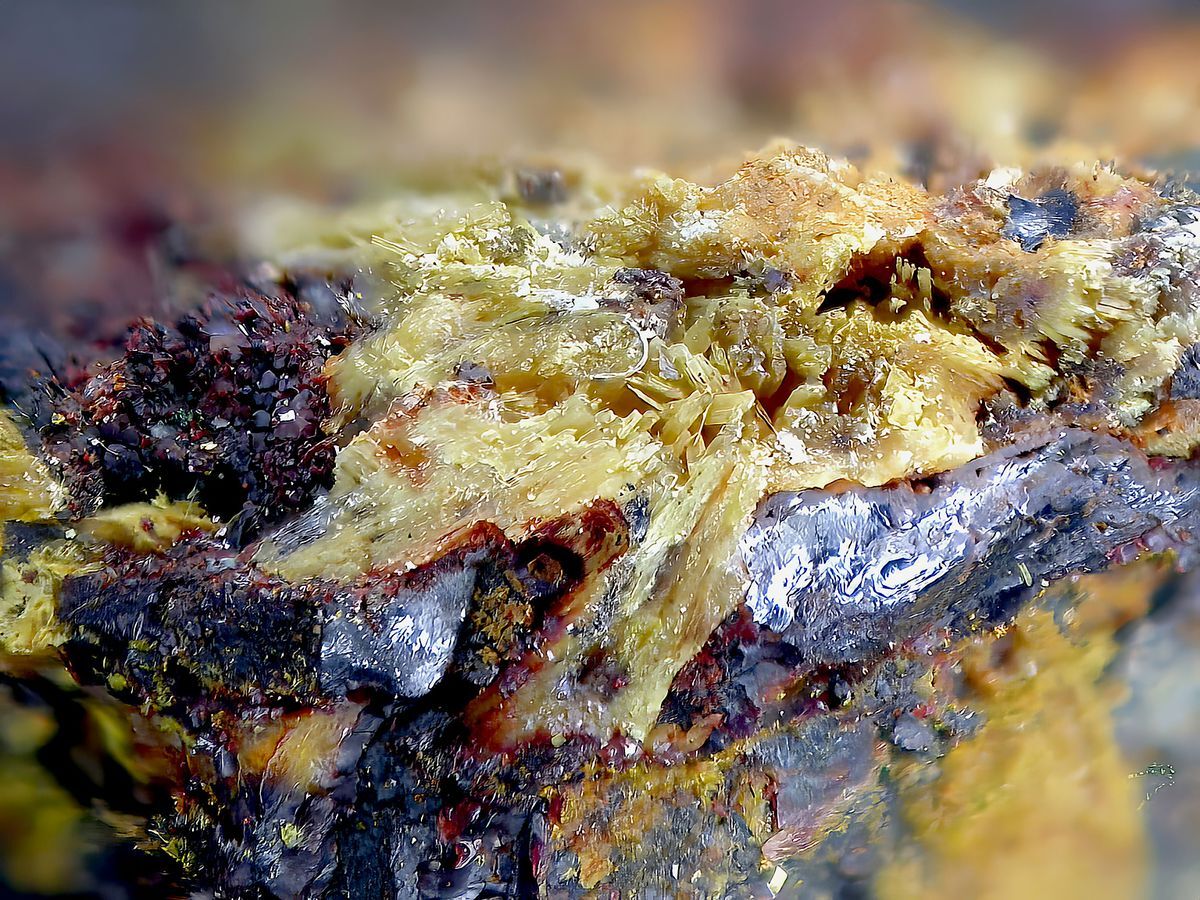
What is Allanpringite? Allanpringite is a rare phosphate mineral named after the Australian mineralogist Allan Pring. This mineral stands out due to its unique chemical formula, Fe3+3(PO4)2(OH)3·5H2O, which indicates it is a hydrated iron phosphate. Found in abandoned iron mines, allanpringite forms needle-like, pale brownish-yellow crystals that are always twinned. Its perfect cleavage, vitreous luster, and translucent nature make it a subject of interest for mineralogists. With a Mohs hardness of 3, it is relatively soft. Allanpringite's optical properties, including its biaxial positive nature and distinct pleochroism, further add to its scientific significance.
Key Takeaways:
- Allanpringite is a unique iron phosphate mineral with needle-like crystals and a pale brownish yellow color. It forms in abandoned iron mines and is associated with other minerals like wavellite.
- Named after Australian mineralogist Allan Pring, allanpringite's properties contribute to our understanding of phosphate mineralogy and geological processes. Its biaxial positive nature and associations make it a subject of scientific interest.
What is Allanpringite?
Allanpringite is a fascinating mineral named after Australian mineralogist Allan Pring. This phosphate mineral has unique properties that make it a subject of interest in geology and chemistry. Let's dive into some intriguing facts about allanpringite.
-
Definition and Classification: Allanpringite is a phosphate mineral with the chemical formula Fe3+3(PO4)2(OH)3·5H2O, indicating it is a hydrated iron phosphate.
-
IMA Symbol and Strunz Classification: The International Mineralogical Association (IMA) symbol for allanpringite is Apg. It falls under the Strunz classification 8.DC.50 and Dana classification 42.10.02.02.
Crystal Structure and Physical Properties
Understanding the crystal structure and physical properties of allanpringite helps in identifying and studying this mineral.
-
Crystal System and Structure: Allanpringite crystallizes in the monoclinic crystal system, distinct from its analogue wavellite, which has an orthorhombic structure. Its space group is P21/n.
-
Unit Cell Parameters: The unit cell parameters are a = 9.777 Å, b = 7.358 Å, c = 17.83 Å, and β = 92.19°. The unit cell volume is about 473.97 ų, with a Z value of 4, meaning four formula units per unit cell.
-
Formula Mass: The formula mass of allanpringite is 498.07 g/mol, providing insight into its molecular weight and composition.
-
Color and Crystal Habit: Allanpringite typically exhibits a pale brownish yellow color and forms acicular crystals, often needle-like. These crystals are always twinned and form parallel bundles up to about 2 mm long.
-
Cleavage and Fracture: It shows perfect cleavage along the {hk0} planes and good cleavage along the {010} planes. Its fracture is irregular/uneven, and it is brittle.
-
Mohs Scale Hardness: Allanpringite has a Mohs scale hardness of 3, indicating it is relatively soft compared to other minerals.
-
Luster and Streak: The luster of allanpringite is vitreous, giving it a glassy appearance. Its streak is pale yellowish white.
-
Diaphaneity: Allanpringite is translucent to transparent, allowing light to pass through it to some extent.
-
Specific Gravity: The specific gravity is measured at 2.54 and calculated at 2.583, indicating its density relative to water.
Optical Properties
The optical properties of allanpringite are crucial for identifying it under a microscope.
-
Optical Properties: Allanpringite is biaxial positive, with refractive indices nα = 1.662, nβ = 1.675, and nγ = 1.747. The birefringence is 0.085, and the 2V angle is calculated to be 48°.
-
Surface Relief and Pleochroism: It exhibits high surface relief and visible pleochroism. The pleochroic colors range from pale olive-green to reddish brown, dark brown to brownish yellow, and dark reddish brown to greenish brown, depending on the crystal's orientation.
-
Dispersion: Allanpringite shows distinct to strong dispersion, meaning it exhibits a separation of colors when viewed under a polarizing microscope.
Formation and Occurrence
Allanpringite forms under specific geological conditions and is found in certain environments.
-
Formation: Allanpringite typically forms in association with other iron phosphates in abandoned iron mines. Its formation is closely related to the presence of iron and phosphate ions.
-
Association with Other Minerals: It often forms in association with minerals like wavellite, its analogue. It also co-occurs with other iron phosphates.
-
Occurrence: Allanpringite has been identified in various locations worldwide, including abandoned iron mines where the necessary conditions for its formation are present. Its occurrence is relatively rare compared to other phosphate minerals.
Allan Pring and Scientific Significance
The mineral is named after a notable mineralogist and holds significant scientific value.
-
Allan Pring: Allan Pring, after whom the mineral is named, is an Australian mineralogist known for his contributions to mineralogy. His work has been instrumental in identifying and classifying various minerals, including allanpringite.
-
Metrical and Structural Match: The close metrical and structural match between allanpringite and wavellite explains their epitaxy, meaning their crystal structures align in a specific way, leading to their formation together in certain environments.
-
Needle-Like Crystals: Allanpringite's needle-like crystals are a distinctive feature. These crystals are always twinned and form parallel bundles, which can be up to 2 mm long.
Additional Properties and Associations
Some additional properties and associations of allanpringite add to its uniqueness.
-
Radioactivity: While allanpringite itself is not radioactive, it can contain minor amounts of uranium (U) and thorium (Th), making it slightly radioactive. This property is often observed in metamict allanites, which are isotropic and have a lower refractive index.
-
Metamict Allanites: Metamict allanites are isotropic and have a lower refractive index compared to non-metamict allanites. They often contain minor amounts of uranium and thorium, causing them to become metamict over time.
-
Associated Minerals: Allanpringite is often associated with minerals such as quartz, yttrofluorite, albite, microcline, dolomite, bastnäsite-(Ce), titanite, calcite, diopside, and muscovite. These associations provide valuable information about its geological environment and formation conditions.
-
Scientific Significance: The study of allanpringite contributes significantly to our understanding of phosphate mineralogy and the geological processes forming these minerals. Its unique properties and associations with other minerals make it an important subject in both academic and industrial research.
-
Optical Data: The optical data for allanpringite include its biaxial positive nature, with specific refractive indices and birefringence values. These properties are crucial for identifying the mineral under a polarizing microscope.
Final Thoughts on Allanpringite
Allanpringite, a unique phosphate mineral, stands out with its monoclinic crystal system and pale brownish yellow color. Named after Australian mineralogist Allan Pring, it forms needle-like, twinned crystals often found in abandoned iron mines. With a Mohs hardness of 3 and a specific gravity of 2.54, it's relatively soft and light. Its biaxial positive optical properties and pleochroism make it fascinating under a microscope. Allanpringite's close relationship with wavellite and other iron phosphates highlights its geological significance. Though rare, its study offers valuable insights into phosphate mineralogy and the Earth's geological processes. Understanding allanpringite not only enriches our knowledge of minerals but also underscores the intricate beauty and complexity of our planet's crust.
Frequently Asked Questions
Was this page helpful?
Our commitment to delivering trustworthy and engaging content is at the heart of what we do. Each fact on our site is contributed by real users like you, bringing a wealth of diverse insights and information. To ensure the highest standards of accuracy and reliability, our dedicated editors meticulously review each submission. This process guarantees that the facts we share are not only fascinating but also credible. Trust in our commitment to quality and authenticity as you explore and learn with us.


